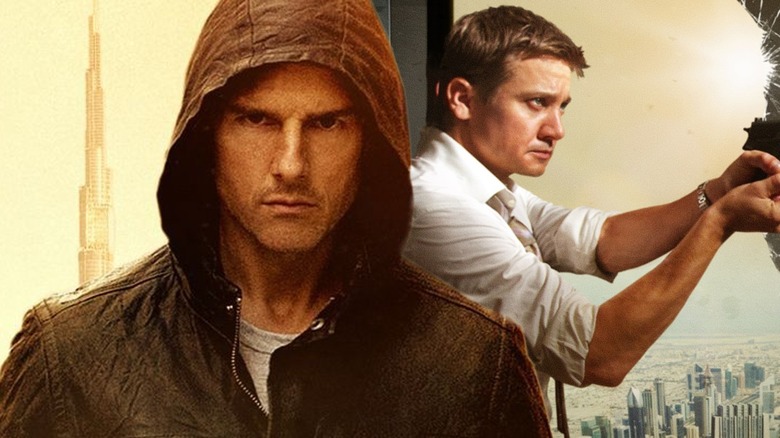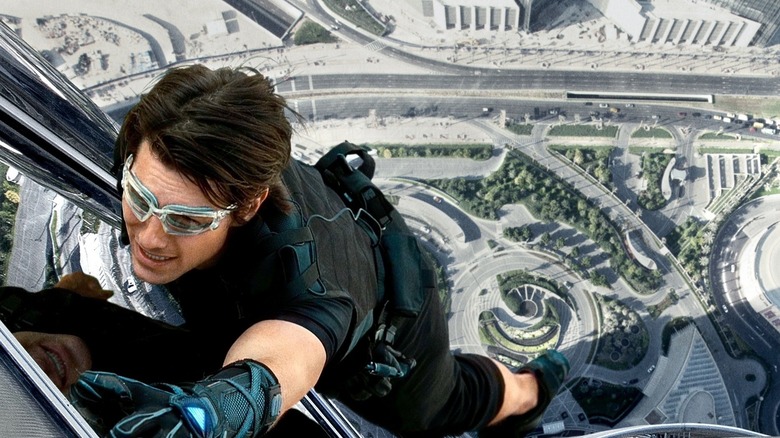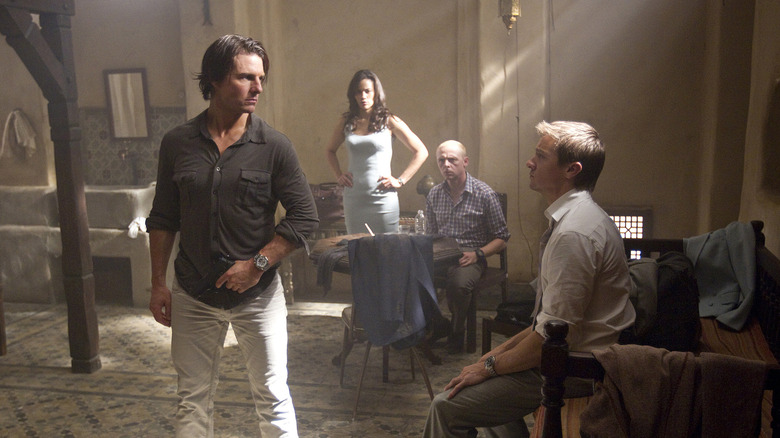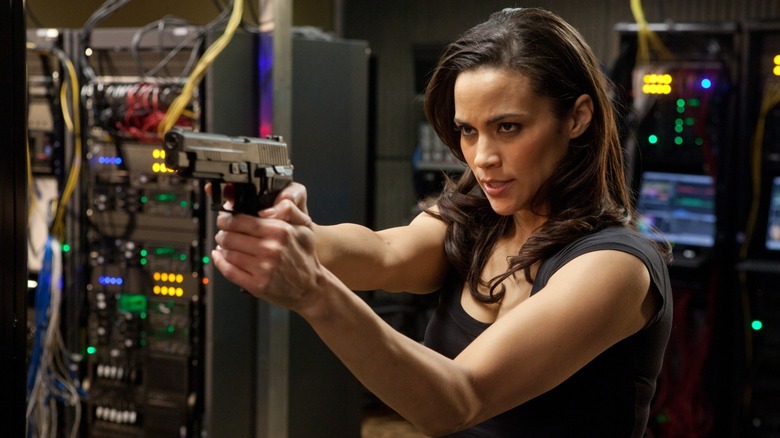Tales From The Box Office: Mission: Impossible — Ghost Protocol's Biggest Stunt Was Its Massive Success
The "Mission: Impossible" franchise, much like the name implies, has been a downright impossible and wild thing in the Hollywood landscape. The movies have, against all odds, survived since 1996 when the original, somewhat humble action flick — starring Tom Cruise and based on the TV show of the same name — was released. They have never been rebooted in 25 years, and there are two more movies on the way, with Cruise still at the center of it all as Ethan Hunt.
It could be argued that the franchise hit its apex when "Mission: Impossible – Ghost Protocol" was released back in December 2011. Even if it's not the "best" of the bunch, it is certainly the most important. As the movie gets ready to celebrate its tenth anniversary this week, I decided to have a look back at how the fourth entry "Mission: Impossible" movie came to be, how much it had to overcome to make it to the finish line, and how it is entirely unique in the landscape of gigantic hit blockbuster movies.
The Movie: Mission: Impossible - Ghost Protocol
J.J. Abrams made his feature directorial debut with "Mission: Impossible III" back in 2007. The movie managed to rebound critically from "Mission: Impossible 2," which is still for my money the only bad one of the bunch. But Abrams was busy with "Super 8" and couldn't return to the director's chair once Paramount Pictures decided they wanted to proceed with a fourth entry. Even though "M:I3" wasn't a massive hit, it was a turnaround in the eyes of critics and, with Cruise on board, there was reason to think there was gas left in the tank.
The studio then made the unique choice to turn to Brad Bird, known for his work on "The Iron Giant" and "The Incredibles," among other animated blockbusters. It would serve as Bird's first live-action feature, and one of only two he's done to date alongside the disastrous "Tomorrowland." Josh Appelbaum and André Nemec ("Alias") penned the initial screenplay, though their draft would end up needing a lot of help. Enter Christopher McQuarrie.
McQuarrie had been working primarily as a screenwriter in Hollywood, and had worked with Cruise on "Valkyrie." But it was this movie where their relationship would truly blossom, creating the most significant creative partnership in Cruise's storied career. McQuarrie was brought in to handle uncredited rewrites on the complex story. Speaking on the "Light the Fuse" podcast, McQuarrie explained it thusly:
"On 'Ghost Protocol,' I came in on the middle of the shoot to do a rewrite of the screenplay, though they had already started the movie. I had to communicate with the entire staff to determine what I could and couldn't change, what sets had been built or struck, what scenes I could or couldn't reshoot. I learned so much about production being right there ... The script had these fantastic sequences in it but there was a mystery in it that was very complicated. What I did was about clarity. The mystery had to be made simpler. It's like reaching into a sock and pulling it inside out. It's still a sock, still all the same pieces, but all put together in a different order."
In the end, despite a long, complex shoot, lots of uncredited rewrites, and some incredibly dangerous stunts involving Cruise hanging off of the tallest building in the world, the movie was in the can by December 2011, to be unleashed on eager audiences all over the place.
The Financial Journey
Paramount took an interesting approach to the movie's release, as much of it was shot in IMAX. To emphasize that, "Mission: Impossible – Ghost Protocol" was released exclusively in IMAX theaters on December 16, and managed to pull in $12.7 million in just 425 theaters on what was technically its opening weekend. Buzz built and, come December 23 when it went wide, things went well. "Ghost Protocol" earned $29.5 million domestically in its first weekend of wide release, and things just kept rolling from there.
It then dropped less than 1% the following week, taking in another $29.4 million, with solid holds during the rest of its run. The movie finished with $209.3 million domestically and, as luck would have it, international audiences turned out in droves as well to the tune of $485.3 million. That brought its grand total to $694.7 million. Much of that was aided by premium format screens, as the over-the-top stunts and action demanded to be seen on the biggest screen possible.
"Mission: Impossible — Ghost Protocol" was the biggest movie of Cruise's career up to that point, and remains the second-highest grossing entry in the series overall. 2018's "Mission: Impossible — Fallout" ($787 million) would eventually top it, but "Ghost Protocol" paved the way. More than anything, it's downright remarkable that the fourth movie in a franchise that was 15 years old at that point somehow managed to completely reinvigorate it. Same leading man. Same continuity, but just the right combination of spectacle and timing. One would be hard-pressed to find another example of that happening in Hollywood history, but especially at this scale.
The Lessons Contained Within
One of the biggest lessons for me here is that Paramount made a reasonable bet here. Yes, big movie star and established franchise (especially a decade ago before streaming took hold) was a safe bet at the box office, but the studio didn't let things get out of hand. This movie was made for $145 million, and yes, that is a big budget, but it's not overly inflated. It's actually $5 million less than the reported budget for "Mission: Impossible III." Set yourself up to succeed.
Beyond that, I think the idea of not fixing what isn't broken was incredibly wise. It would have been easy to look at what "MI3" did at the box office and pivot. Instead, they kind of doubled down on what worked and didn't force anything. They brought in the right guy to right the ship during production when things weren't working, but ultimately stayed the course. Clearly, that paid off.
Also of note, the "Mission: Impossible" movies to this day are not overly married to continuity. That can be a killer in some cases. For as much as the Marvel Cinematic Universe works, it can be a lot of homework. Even the Daniel Craig "Bond" movies were a little too interconnected for their own good at times (looking at you, "Spectre"). With "Ghost Protocol," an audience member who had never seen one of these movies could have easily understood what was going on and just go on the ride. Fortunately, even though "Fallout" had a lot of ties to previous movies, the franchise has kept that up.
Lastly, to the idea that recognizing a good thing is a smart way to go, Paramount recognized that McQuarrie had a magic touch. Ultimately, he was brought on board to direct "Rogue Nation" and "Fallout," both of which were gangbusters big hits. And he has also worked with Cruise on "Edge of Tomorrow," "Jack Reacher," and the upcoming "Top Gun: Maverick." Plus, he's directing both "Mission: Impossible 7" and "8." It is one of the single most reliable relationships in Hollywood, and it largely blossomed as a result of some uncredited rewrites. That's a hell of a thing.



